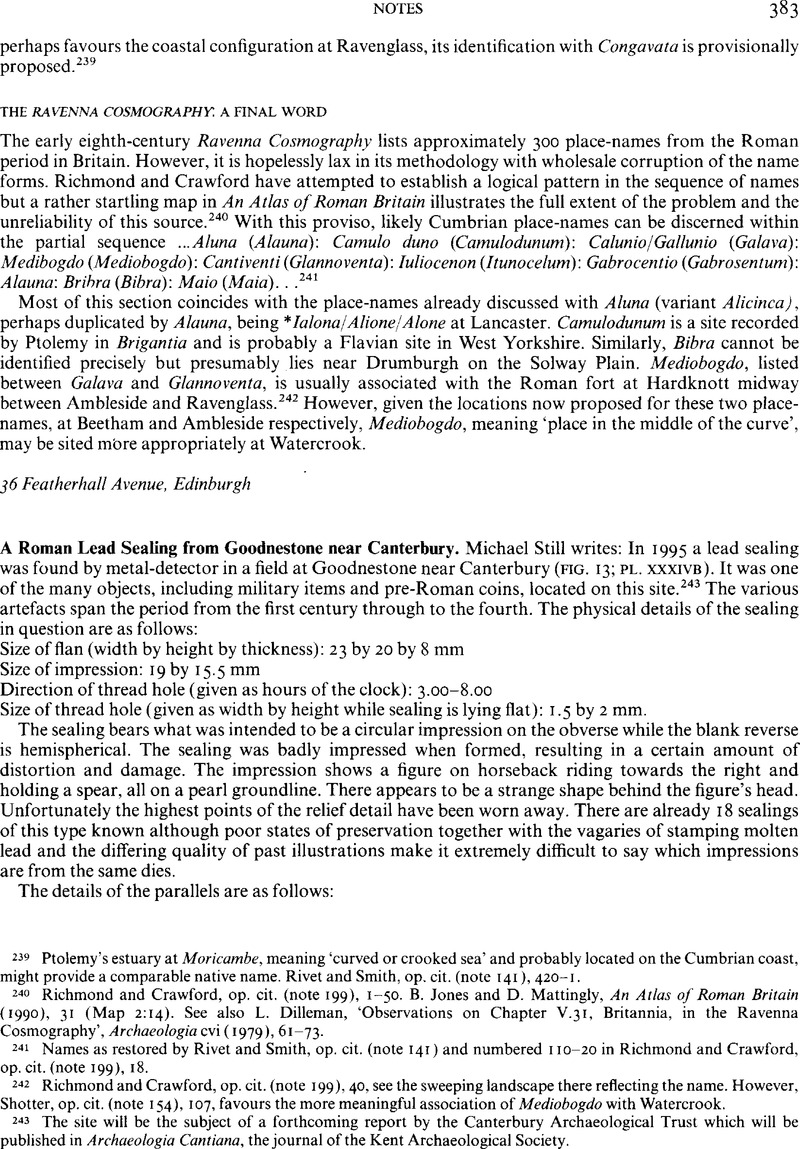Published online by Cambridge University Press: 09 November 2011

244 J.P. Bushe-Fox, Fourth Report on the Excavations of the Roman Fort at Richborough (1949), 138, no. 164 and pl. xliv.
245 Still, M.C.W., Roman Lead Sealings, PhD thesis, University of London (1995)Google Scholar , No. 284 and, misidentified as Pegasus due to corrosion, no. 779. M y thanks to Catherine Johns for allowing m e to examine these items.
246 N. Mills, Roman Artefacts found in Britain (1995), 74, M215.
247 Cuppers, H., ‘Ausgewählte römische Moselfunde’, Trierer Zeitschrift xxxvii (1974), 149–73, no. 6, pl. 14.Google Scholar
248 H.-J. Leukel, Römische Bleiplomben aus Trierer Funden (1995), 105-6, nos 418-30.
249 The search for comparisons in coin catalogues has been hindered by the brief descriptions lacking any differentiation between spears held overarm and underarm and by the paucity of photographs although, where these do appear, overarm is usually shown. Coins depicting the scene, regardless of arm position, are most common under Magnentius (a.d. 350-3) followed by Constantius II (these coins appear from c. 348-53 and are minted only by Magnentius, Nepotian, and Constans in descending order of volume, never by Constantius II himself). The meagre evidence (relying only on references with photographs) for examples definitely showing the spear being held underarm, as in the sealings, consists of a coin of Maximian (RIC VI Cyzicus no. 3, c. a.d. 294-9), a medallion of Constantine II given in L.M. Tocci, I Medaglioni Romani e i contorniati del Medagliere Vaticano (1965), 144, pl. LV no. 102, a coin of Constantius II (RIC VIII Rome no. 103A, c. a.d. 348 presumably minted by Constans), and a medallion of Magnentius’ Caesar, Decentius (a.d. 350-3) given in H.A. Grueber and R.S. Poole, Roman Medallions in the British Museum (1874), 94, pl. LXIV. For the possible shape which appears behind the rider's head on our sealing perhaps we should consider a coin of Constantine I (RIC VII Rome no. 308, a.d. 327-33) which depicts a similar scene with the mounted emperor being crowned by a flying Victory (but with no information as to the position of the emperor's arm).
250 It is beyond our scope to dwell upon possible local officials here but see the diagrammatic representation of the late Roma n hierarchy in M.W.C. Hassall, ‘Britain in the Notitia’, in R. Goodburn and P. Bartholomew (eds), Aspects of the Notitia Dignitatum, BAR S-15 (1976), 103-17.
251 RIB 2411.38; Landesmuseum Trier, Trier, Kaiserresidenz und Bischofssitz (1984), 242, nos 130a &b.
252 I would like to thank Richard Cross of the Canterbury Archaeological Trust for allowing me to examine and publish this sealing and Karsten Dahmen of the Archäologisches Seminar und Museum der Westfälischen Wilhelms-Universität, Münster, for informing me of, and providing photocopies of, Leukel's work.